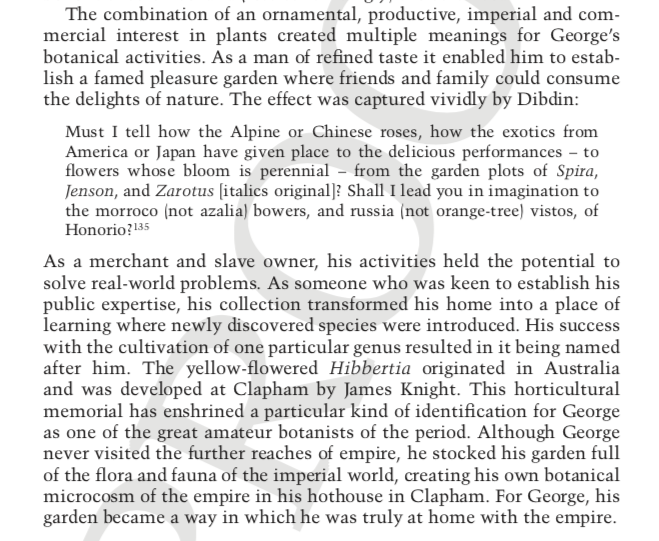Following another reductive misrepresentation of work by @corinne_fowler @ColonialCountr1 a thread on botany & slavery. Pic: yellow leaved Hibbertia, native 2 Australia. Named 4 George Hibbert - slave-owner/amateur botanist. His collecting utlised his imperial commercial networks
He sent his gardeners out 2 empire 2 collect plant specimens. As Kenneth Cozens documented: Francis Masson traveled 2 the Cape of Good Hope aboard the HMS Resolution, on Captain James Cook’s Second Voyage of discovery to collect plants on behalf of Hibbert https://www.academia.edu/12319084/George_Hibbert_of_Clapham_18th_Century_Merchant_and_Amateur_Horticulturalist
Hibbert used his botanical knowledge to gain membership to @royalsociety where he was involved with imperial / commercial / botanical projects including a proposal 2 introduce the silk worm 2 Jamaica. Science & botany were part of the imperial project https://catalogues.royalsociety.org/CalmView/Record.aspx?src=CalmView.Persons&id=NA3178&pos=1
From the mid-eighteenth century through to the immediate aftermath of abolition, 22 slave & plantation owners have been identified as Fellows of the Royal Society by the Legacies of British Slave-ownership project https://www.ucl.ac.uk/lbs/search/
The Hibberts were involved in the expedition 2 transport breadfruit from the South Pacific to the Caribbean. Why? Because breadfruit was a potential cheap source of food 4 enslaved people. The Royal Society sponsored the attempt & Captain William Bligh led the expedition.
Bligh was connected 2Caribbean slavery: his wife’s uncle Duncan Campbell was an absentee planter who owned the Salt Spring estate in Jamaica. Between 1784-1787 Bligh lived in Jamaica, acted as his agent & served on Campbell’s ships transporting sugar & rum https://www.smithsonianmag.com/travel/captain-blighs-cursed-breadfruit-41433018/
When Bligh arrived in Kingston harbour in 1793 the Royal Gazette noted that the slave trader / plantation owner Robert Hibbert (George's brother) was given a specimen 2 grow. Breadfruit is now a national dish in many areas of the Caribbean.
Another example: In 1792 the botanist Thomas Dancer recorded ‘Aka Africana Another African fruit, introduced by Negroes in some of Mr. Hibbert’s ships’. The common name for the aka is ackee & the fruit is one of the national dishes of Jamaica.
George sent James Macfadyen (Scottish botanist) 2Jamaica. He was sent 2 'collect for his private botanical garden in Clapham’. Macfadyen was employed as Island Botanist in Jamaica 1826-1828. He founded Jamaica Botanic Garden. His collection is @kewgardens https://www.internationalstory.gla.ac.uk/person/?id=WH13514
Back in England, Hibbert's Clapham Common garden achieved fame 4 its rare blooms grown in his private hot house. Royalty & men of science visited 2 view the collection. Some flowers we know 2day were 1st grown by Hibbert. Here is Curtis Botanical Magazine discussing the magnolia:
Hibbert's herbarium was donated to @LinneanSociety (where he was also a member) before becoming part of the @NHM_London collection. This is part of our history & heritage. Understanding this enhances our knowledge of our contemporary society's interconnected imperial roots.
This is an extract from the conclusion of a chapter in my book The Bonds of Family which explores the history and meaning of George Hibbert's collecting practices (art, books, botany):
https://manchesteruniversitypress.co.uk/9781526129482/
https://manchesteruniversitypress.co.uk/9781526129482/

 Read on Twitter
Read on Twitter





